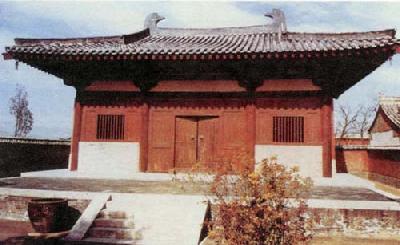Chinese architecture constitutes the only system based mainly on wooden structures of unique charming appearance. This differs from all other architectural systems in the world which are based mainly on brick and stone structures.
There are four extant wooden structures of the Tang Dynasty (618-907), all of them being Buddhist halls in Shanxi. They are very valuable; especially important are the two big halls -- Nanchan Temple and Foguang Temple.
 |
Located in Doucun Village at the foot of Wutai Mountains, the Foguang Temple, founded in the 11th year (857) of Tang Emperor Dazhong, is a medium-sized hall standing on the terrace at the back of the temple.
The plane of the big hall is of rectangular shape. It consists of seven rooms in the front, with a circle of inner pillars within the hall dividing it into the heart and the surrounding two parts. In the heart is a Buddhist altar on which there are five groups of statues in tacit coordination with buildings. The roof is single-eavedWudian, the slope of the house is also gentle.